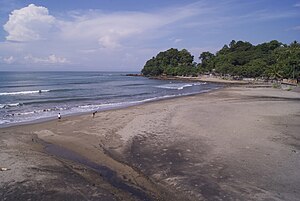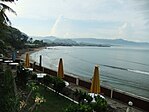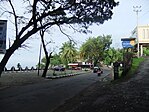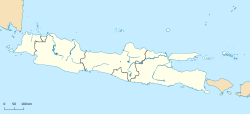Sukabumi Regency
Kabupaten Sukabumi | |
|---|---|
| Regional transcription(s) | |
| • Sundanese | ᮊᮘᮥᮕᮒᮦᮔ᮪ ᮞᮥᮊᮘᮥᮙᮤ |
Clockwise, from top left : Karanghawu Beach, Streetscape of Pelabuhan Ratu, Cikaso waterfall, Pelabuhan Ratu Bay | |
| Motto(s): Gemah Ripah Loh Jinawi ᮌᮨᮙᮂ ᮛᮤᮕᮂ ᮜᮧᮂ ᮏᮤᮔᮝᮤ Prosperous, Serene, Abundantly Fertile | |
 Location within West Java | |
| Coordinates: 6°59′19″S 106°33′03″E / 6.9886°S 106.5508°E | |
| Country | Indonesia |
| Province | West Java |
| Consolidated | 1 June 1921 |
| Anniversary Day | 1 October 1945 |
| Regency seat | Palabuhanratu |
| Administrative divisions | 47 Districts 386 Villages |
| Government | |
| • Regent | Marwan Hamami |
| • Vice Regent | Iyos Somantri |
| Area | |
| • Total | 4,164.15 km2 (1,607.79 sq mi) |
| Highest elevation | 3,019 m (9,905 ft) |
| Lowest elevation | 0 m (0 ft) |
| Population (mid 2023 estimate) | |
| • Total | 2,802,404 |
| • Density | 670/km2 (1,700/sq mi) |
| [1] | |
| Time zone | UTC+7 (Indonesia Western Time) |
| Postal code(s) | 431xx, 433xx |
| Area code | +62 266 |
| Vehicle registration | F |
| HDI | |
| Website | sukabumikab.go.id |
Sukabumi Regency (Indonesian: Kabupaten Sukabumi; Sundanese: ᮊᮘᮥᮕᮒᮦᮔ᮪ ᮞᮥᮊᮘᮥᮙᮤ) is a regency (kabupaten) in southwestern Java, as part of West Java province of Indonesia. The regency seat is located in Palabuhan Ratu, a coastal district facing the Indian Ocean. The regency fully encircles the administratively separated city of Sukabumi. Covering an area of 4,164.15 km2, the regency is the largest regency in West Java and the second largest regency on Java after the Banyuwangi Regency in East Java. The regency had a population of 2,341,409 at the 2010 census[2] and 2,725,450 at the 2020 census;[3] the official estimate as at mid 2023 was 2,802,404 (comprising 1,421,474 males and 1,380,930 females),[1] with a large proportion of it living in the northeastern part of the regency that encircles Sukabumi City, south of Mount Gede. A plan to create a new regency, the putative North Sukabumi Regency, is currently waiting for the approval of the central government, which has been deferred until the end of the current morotorium on new creations of regencies.[4]
Sukabumi is strategically located south of Jabodetabek (the Jakarta Metropolitan Area) and west of the Bandung Metro, two largest metropolitan area in Indonesia. Geologically, the regency is at the western end of the Cimandiri Fault, which splits the northern plateau from the southern hilly areas.[5][6][7] Its southern region is less populated and contains a high level of biodiversity and significant geological heritage, acknowledged in 2015 by UNESCO with the declaration of Ciletuh-Palabuhanratu Geopark located in the southwestern coast of the regency.[8][9][10][11]
History[edit]
Early history[edit]
The area around Sukabumi was already inhabited at least in the 11th century. The first written record found in this area was the Sanghyang Tapak inscription in Cibadak District, 20 km west of Sukabumi. Written in Kawi script, the stone tells about the prohibition of fishing activity in the nearby river by the authorities of the Sunda Kingdom.[12] Another written record found is the undeciphered Pasir Datar Inscription in the Cicantayan District.
After the fall of Sunda Kingdom in 1579, most of present-day Sukabumi Regency was under the control of Sumedang Larang, while the area west of Mount Gede was controlled by the Banten Sultanate. In 1620, King Aria Suriadiwangsa of Sumedang Larang declared his kingdom as part of Mataram Sultanate.[13][14][15] During this era, Dipati Ukur, the local ruler of present-day Bandung revolted against Mataram after the failed Siege of Batavia. The revolt triggered migration of people from Sumedang Larang to move and settle the area around Palabuhanratu and Jampang to protect themselves from the approaching Mataram troops.[16][17]
After Sultan Agung died in 1645, the Priangan region slowly broke away from Mataram influence.[18] In 1674, Trunajaya rebellion started in Madura and greatly weakened Mataram.[19] Sukabumi, which was still a part of Cianjur, declared itself independent from Mataram under the leadership of Wiratanu I in 1677, when Trunajaya forces sacked the Plered Palace in Mataram's capital.[20][21][22] The Sultanate itself was officially ceded Priangan region west of Citarum to the VOC on October 20, 1677, by an unequal treaty between Amangkurat II and Maetsuycker, as a compensation for Dutch assistance to quell the Trunajaya rebellion.[23][24][25][26] By that time, there were only few rural Sundanese settlements existed, one of the largest was Cikole.[27] Under the leadership of Sultan Ageng Tirtayasa, Banten tried to reclaim Priangan between 1677 and 1683 via an invasion of Cianjur, however his effort was ultimately failed when Banten descended into civil war between Ageng and his crown prince Abdul Kahhar.[14][20][28][29]
Colonial era[edit]
The inland and coastal areas of Sukabumi were first explored by Europeans at the end of the 17th century, when VOC planned to open plantations throughout Priangan.[30][31] The first Dutch expedition was led in 1687 by Pieter Scipio van Oostende into the remnant of Pakuan and ended on Wijnkoopsbaai (present-day Palabuhanratu).[32][33] The next expeditions were led by Adolf Winkler in 1690,[34] and governor-general Abraham van Riebeeck in 1703, 1704, and 1709. In the 1709 expedition Van Riebeeck passed through Mount Gede and visited southern Sukabumi to check on the progress of coffee cultivation in that area.[35][36] One of the first coffee plantation opened by Van Riebeeck was located in present-day Gunungguruh District.[37] The first coffee harvest was officially sent on April 14, 1711, by Tjiandjoer regent Wiratanu III.[38] In 1723, The coffee plantation areas in Sukabumi were grown, along with the enlargement of Tjiandjoer Regency during the administration of Hendrick Zwaardecroon.[39][40][41]
Formation[edit]
The regency was originally carved out from the colonial era-Tjianjoer Regency. It was then part of the Priangan Residency (Residentie Preanger Regentschappen). In 1776, the regent of Tjianjoer Wiratanu Datar VI created a kepatihan (viceregency) named Tjikole Viceregency which consisted of the districts of Goenoengparang, Tjimahi, Tjiheoelang, Tjitjoeroeg, Djampangtengah and Djampangkoelon, with its administrative center in Tjikole (now part of Sukabumi).
On January 13, 1815, under the British rule, the Tjikole Viceregency was renamed as Soekaboemi Viceregency. The name Soekaboemi was proposed by a Dutch surgeon and plantation owner named Dr. Andries de Wilde, who owned a plantation and resided in the viceregency. The origin of the name came from the combination of two Sanskrit words, Soeka (happiness, likely) and Boemi (earth, land). Thus Soekaboemi could be translated as "Likable Land".
In 1921, by the decree of Governor General Dirk Fock, Tjiandjoer Regency was divided into two regencies, Tjiandjoer and Soekaboemi regencies, effective from June 1, 1921.[42] The first regent of Soekaboemi was R. A. A. Soerianatabrata, who also held position as Sukabumi's last viceregent. He held this position until 1930.[43] From 1926 to 1931, Soekaboemi served as the capital of the short-lived West Priangan Residency.[44][45]
Geography[edit]
The regency borders the Cianjur Regency in the east, Bogor Regency in the north, Lebak Regency (of Banten Province) in the west, and the Indian Ocean in the south.
Beaches[edit]
Along the southern coast of the regency there are several beaches such as Pasir Putih Beach (Cipanarikan estuary), Pangumbahan Beach (also known as Turtle Beach), Cibuaya Beach and Ujunggenteng Beach. Batununggul Beach is suitable for surfing with average wave height approximately 3 meters in dry season, but only 1 meter in rainy season.[46]
Waterfalls[edit]
The 120-meters Caweni Waterfall is located only 200 metres from Cidolog road, about 70 kilometres south of Sukabumi and about 25 kilometres from Sagaranten District.[47]
The Cikaso Waterfall (Ciniti Waterfall) is located in Jampang Kulon district, 1.5 hours drive (70 kilometres) from Sukabumi City. The waterfall height is 80 metres; it consists of 3 waterfalls, from left to right Asepan Waterfall, Meong Waterfall and Aki Waterfall.[48]
Culture[edit]
Sukabumi, with Cianjur, is a part of the western Parahyangan cultural region, a fertile mountainous region of West Java which is home to the Sundanese people.
Traditional festivities[edit]
The local people hold the Ocean Fiesta every year on 5 April in Pelabuhan Ratu Beach. There is also Ngabungbang tradition in Cisukawayana river estuary on every full moon of each month in early morning. Ngabungbang or Mass ritual bath is a pre-Islamic tradition since 175-205 BC when King Hyang Brahma ruled Medang Gali (Galuh) Kingdom and continued by Prabu Siliwangi from Sunda Kingdom until now.[49]
Administrative districts[edit]
As at 2021, Sukabumi Regency is divided into forty-seven districts (kecamatan), listed below with their areas and their populations at the 2010 census[2] and the 2020 census,[3] together with the official estimates as at mid 2023.[1] These exclude the further seven districts which are within the city of Sukabumi (and thus administratively outside the regency). The table also includes the locations of the district administrative centres, the number of villages in each district (totaling 381 rural desa and 5 urban kelurahan), and its postal code.
| Kode Wilayah |
Name of District (kecamatan) |
Area in km2 |
Pop'n 2010 census |
Pop'n 2020 census |
Pop'n mid 2023 estimate |
Admin centre (a) |
No. of villages |
Post code |
|---|---|---|---|---|---|---|---|---|
| 32.02.22 | Ciemas (b) | 304.48 | 48,081 | 55,837 | 57,362 | Tamanjaya | 9 | 43177 |
| 32.02.26 | Ciracap | 148.53 | 47,495 | 56,073 | 57,881 | Ciracap | 8 | 43176 |
| 32.02.20 | Waluran | 98.82 | 25,951 | 30,788 | 31,826 | Waluran | 6 | 43175 |
| 32.02.24 | Surade | 119.34 | 72,083 | 82,173 | 83,964 | Surade | 12 (c) | 43179 |
| 32.02.25 | Cibitung | 88.84 | 25,066 | 29,766 | 30,778 | Cibitung | 6 | 43172 |
| 32.02.21 | Jampang Kulon | 62.59 | 41,396 | 47,498 | 48,625 | Jampang Kulon | 11 (c) | 43170 |
| 32.02.46 | Cimanggu | 62.58 | 22,104 | 26,214 | 27,094 | Cimanggu | 6 | 43178 |
| 32.02.23 | Kalibunder | 86.08 | 27,175 | 31,758 | 32,685 | Kalibunder | 7 | 43185 |
| 32.02.45 | Tegalbuleud | 255.54 | 33,443 | 36,550 | 36,892 | Tegalbuleud | 8 | 43186 |
| 32.02.43 | Cidolog | 95.73 | 17,518 | 17,607 | 17,345 | Mekarjaya | 5 | 43184 |
| 32.02.41 | Sagaranten | 113.02 | 47,309 | 53,198 | 54,142 | Sagaranten | 12 | 43181 |
| 32.02.44 | Cidadap | 85.81 | 18,663 | 19,877 | 19,913 | Padasenang | 6 | 43183 |
| 32.02.42 | Curugkembar | 55.87 | 28,463 | 31,322 | 31,678 | Curugkembar | 7 | 43182 |
| 32.02.37 | Pabuaran | 115.70 | 39,590 | 44,621 | 45,443 | Pabuaran | 7 | 43173 |
| 32.02.07 | Lengkong | 146.51 | 29,222 | 33,436 | 34,201 | Lengkong | 5 | 43174 |
| 32.02.01 | Palabuhanratu | 91.77 | 96,675 | 115,813 | 120,054 | Palabuhanratu | 10 (c) | 43364 |
| 32.02.02 | Simpenan | 167.93 | 48,281 | 57,978 | 60,143 | Cidadap | 7 | 43361 |
| 32.02.09 | Warungkiara | 94.97 | 55,045 | 65,266 | 67,454 | Warungkiara | 12 | 43362 |
| 32.02.04 | Bantargadung | 76.01 | 35,234 | 41,319 | 42,568 | Bojonggaling | 7 | 43363 |
| 32.02.08 | Jampang Tengah | 198.49 | 63,012 | 71,007 | 72,312 | Jampang Tengah | 11 | 43171 |
| 32.02.38 | Purabaya | 116.02 | 39,486 | 44,816 | 45,734 | Purabaya | 7 | 43187 |
| 32.02.10 | Cikembar * | 89.84 | 79,303 | 94,692 | 98,066 | Cikembar | 10 | 43157 |
| 32.02.39 | Nyalindung | 104.38 | 46,167 | 52,357 | 53,418 | Nyalindung | 10 | 43196 |
| 32.02.40 | Gegerbitung * | 67.65 | 36,511 | 42,383 | 43,535 | Gegerbitung | 7 | 43197 (d) |
| 32.02.33 | Sukaraja * | 42.00 | 77,015 | 94,057 | 98,048 | Sukaraja | 9 | 43192 |
| 32.02.34 | Kebonpedes | 10.83 | 27,097 | 33,505 | 35,053 | Kebonpedes | 5 | 43194 |
| 32.02.35 | Cireunghas * | 30.72 | 31,359 | 36,160 | 37,071 | Cireunghas | 5 | 43193 |
| 32.02.36 | Sukalarang * | 30.90 | 41,777 | 50,559 | 52,565 | Cimangkok | 6 | 43191 |
| 32.02.32 | Sukabumi (district) * |
29.91 | 46,251 | 51,505 | 52,271 | Warnasari | 6 | 43151 |
| 32.02.30 | Kadudampit | 69.99 | 50,319 | 58,687 | 60,365 | Kadudampit | 9 | 43153 |
| 32.02.29 | Cisaat * | 21.49 | 113,929 | 129,643 | 132,399 | Cisaat | 13 | 43152 (e) |
| 32.02.27 | Gununggurah * | 26.31 | 48,099 | 56,764 | 58,587 | Gunungguruh | 7 | 43156 |
| 32.02.11 | Cibadak * | 63.06 | 107,623 | 122,288 | 124,835 | Cibadak | 10 (c) | 43351 |
| 32.02.28 | Cicantayan * | 34.80 | 52,716 | 60,990 | 62,587 | Cicantayan | 8 | 43155 |
| 32.02.31 | Caringin * | 36.54 | 43,258 | 51,235 | 52,936 | Caringin Wetan | 9 | 43154 |
| 32.02.12 | Nagrak * | 71.19 | 77,782 | 90,297 | 92,757 | Nagrak Selatan | 10 | 43352 |
| 32.02.47 | Ciambar * | 53.46 | 36,771 | 43,253 | 44,600 | Ciambar | 6 | 43356 |
| 32.02.16 | Cicurug * | 52.16 | 123,088 | 137,019 | 139,041 | Cicurug | 13 (c) | 43359 |
| 32.02.17 | Cidahu * | 35.30 | 60,567 | 74,010 | 77,163 | Jayabakti | 8 | 43358 |
| 32.02.15 | Parakansalak * | 36.88 | 39,409 | 45,911 | 47,208 | Parakansalak | 6 | 43355 |
| 32.02.13 | Parungkuda * | 24.01 | 69,224 | 78,035 | 79,477 | Sundawenang | 8 | 43357 |
| 32.02.14 | Bojonggenteng * | 20.37 | 34,900 | 40,533 | 41,641 | Bojonggenteng | 5 | 43353 |
| 32.02.18 | Kalapanunggal * | 49.37 | 44,587 | 52,731 | 54,458 | Kalapanunggal | 7 | 43354 |
| 32.02.06 | Cikidang * | 155.01 | 55,863 | 68,841 | 71,950 | Cikidang | 12 | 43367 |
| 32.02.05 | Cisolok | 173.47 | 62,076 | 76,235 | 79,599 | Cisolok | 13 | 43366 |
| 32.02.03 | Cikakak | 113.14 | 37,400 | 45,316 | 47,131 | Sukamaju | 9 | 43365 |
| 32.02.19 | Kabandungan * | 136.67 | 37,036 | 45,527 | 47,549 | Kabandungan | 6 | 43368 |
| Totals | 4,164.15 | 2,341,409 | 2,725,450 | 2,802,404 | Palabuhanratu | 386 |
Notes: (a) Of the 47 district capitals, 5 are classed as urban kelurahan (Surade, Palabuhanratu, Cibadak, Cicurug and Jampang Kulon) while the other 42 are rated as rural desa. These 5 are the only kelurahan in the regency.
(b) Ciemas District includes five small offshore islands - Pulau Gotor, Pulau Karanghantu, Pulau Kunti, Pulau Mandra and Pulau Manuk.
(c) including one kelurahan (the district administrative centre). (d) except the village of Caringin, with a post code of 43154.
(e) except the village of Nagrak, with a post code of 43132, and the village of Sukasari, with a post code of 43134.
The creation of a new North Sukabumi Regency (Kabupaten Sukabumi Utara), a proposal under consideration by the Indonesian Parliament since 2013 but currently deferred, would comprise 21 of the above districts from the existing Sukabumi Regency. These 21 districts are indicated by asterisks (*) in the above table.
References[edit]
- ^ a b c Badan Pusat Statistik, Jakarta, 28 February 2024, Kabupaten Sukabumi Dalam Angka 2024 (Katalog-BPS 1102001.3202)
- ^ a b Biro Pusat Statistik, Jakarta, 2011.
- ^ a b Badan Pusat Statistik, Jakarta, 2021.
- ^ Dana Pemekaran Terancam Batal
- ^ "Perpustakaan Digital ITB - WELCOME | Powered by GDL4.2". digilib.itb.ac.id. Retrieved 2017-04-25.
- ^ Gatra (in Indonesian). Era Media Informasi. 2006-01-01.
- ^ Tempo (in Indonesian). Badan Usaha Jaya Press Jajasan Jaya Raya. 2006-01-01.
- ^ "Indonesia to promote geological heritage in Global Geoparks Network". The Jakarta Post. Retrieved 2017-05-07.
- ^ "UNESCO Kukuhkan Ciletuh Sebagai Geopark Nasional". National Geographic Indonesia (in Indonesian). 2015-12-31. Retrieved 2017-04-25.
- ^ "Geopark Ciletuh, Perawan yang Memantaskan Diri". Pikiran Rakyat (in Indonesian). 2016-09-03. Retrieved 2017-04-25.
- ^ "Geopark Ciletuh Juga Miliki Keragaman Budaya". Pikiran Rakyat (in Indonesian). 2016-08-19. Retrieved 2017-04-25.
- ^ Marwati Djoened Poesponegoro, Nugroho Notosusanto (1992). "Kerajaan Sunda". Sejarah nasional Indonesia: Jaman kuna. PT Balai Pustaka. p. 376. ISBN 978-979-407-408-4.
- ^ Sunda, Pusat Studi (2004-01-01). Bupati di Priangan: dan kajian lainnya mengenai budaya Sunda (in Indonesian). Pusat Studi Sunda.
- ^ a b Ch, M. Nasruddin Anshoriy (2008-01-01). Bangsa inlander: potret kolonialisme di bumi Nusantara (in Indonesian). PT LKiS Pelangi Aksara. ISBN 9789791283601.
- ^ G. G. Bandilenko, E.I. Gnevusheva, D.V. Deopik, V.A. Tsyganov (1992). History of Indonesia. pp. 175–179.
{{cite book}}: CS1 maint: multiple names: authors list (link) - ^ Ekajati, Edi Suhardi (1982-01-01). Ceritera dipati ukur: karya sastra sejarah Sundar (in Indonesian). Pustaka Jaya.
- ^ Sasmita, Saleh Dana; Padmadisastra, Sulaiman; Johansyah, Inci; Djenen (1986-01-01). Geografi budaya dalam wilayah pembangunan daerah Jawa Barat: peneliti/penulis, Saleh Danasamita, Sulaeman Padmadisastra, Inci Johansyah (in Indonesian). Departemen Pendidikan dan Kebudayaan, Proyek Inventarisasi dan Dokumentasi Kebudayaan Daerah.
- ^ Behrend, T. E. (1990-01-01). Amarah (in Indonesian). Yayasan Obor Indonesia. ISBN 9789794613313.
- ^ West Java Miracle Sight: A Mass of Verb and Scene Information (in Indonesian). MPI Foundation. 2005-01-01.
- ^ a b Suryaningrat, Bayu (1982). Sajarah Cianjur Sareng Raden Aria Wira Tanu Dalem Cikundul Cianjur. Rukun Warga Cianjur-Jakarta, Jakarta.
- ^ Wajah pariwisata Jawa Barat (in Indonesian). Dinas Pariwisata Propinsi Daerah Tingket I Jawa Barat. 1986-01-01. ISBN 9789798075001.
- ^ Abdurachman (1986-01-01). Naskah Sunda lama di Kabupaten Sumedang (in Indonesian). Pusat Pembinaan dan Pengembangan Bahasa, Departemen Pendidikan dan Kebudayaan.
- ^ Ensiklopedi Jakarta: culture & heritage (in Indonesian). Pemerintah Provinsi Daerah Khusus Ibukota Jakarta, Dinas Kebudayaan dan Permuseuman. 2005-01-01. ISBN 9789798682506.
- ^ Ekajati, Edi Suhardi (1984-01-01). Masyarakat Sunda dan kebudayaannya (in Indonesian). Girimukti Pasaka.
- ^ Younce, William C. (2001-01-01). Indonesia: Issues, Historical Background and Bibliography. Nova Publishers. ISBN 9781590332498.
- ^ Ricklefs, M. C. (2008-09-11). A History of Modern Indonesia Since C.1200. Palgrave Macmillan. ISBN 9781137052018.
- ^ Jaya, Ruyatna (2003). Sejarah Sukabumi. Sukabumi City Government. p. 8.
- ^ Direktori peluang investasi di Provinsi Banten (in Indonesian). Pemerintah Provinsi Banten. 2008-01-01.
- ^ Banten kota pelabuhan jalan sutra (in Indonesian). Departemen Pendidikan dan Kebudayaan, Direktorat Jenderal Kebudayaan, Direktorat Sejarah dan Nilai Tradisional, Proyek Inventarisasi dan Dokumentasi Sejarah Nasional. 1995-01-01.
- ^ Beekman, E. M. (1988). Fugitive Dreams: An Anthology of Dutch Colonial Literature. University of Massachusetts Press. p. 90. ISBN 0870235753.
- ^ Brommer, Bea (2015). To My Dear Pieternelletje:Grandfather and Granddaughter in VOC Time, 1710-1720. Leiden: Brill. p. 19. ISBN 9789004293328.
- ^ Graaf, Hermanus Johannes de (1949-01-01). Geschiedenis van Indonesië (in Dutch). W. van Hoeve.
- ^ Volkslectuur, Dutch East Indies Kantoor voor de (1926-01-01). Nederlandsch Indie: platen atlas met korten beschrijvenden tekst (in Dutch). Volkslectuur.
- ^ deel. Bijlagen. Excursen (in Dutch). Bataviaasch Genootschap van Kunsten en Wetenschappen. 1911-01-01.
- ^ Zakaria, Mumuh M. (2010-01-01). Kota Bogor: studi tentang perkembangan ekologi kota abad ke-19 hingga ke-20 (in Indonesian). Sastra Unpad Press, Fakultas Sastra, Universitas Padjadjaran. ISBN 9786028795081.
- ^ Iguchi, Masatoshi (2017-01-25). Java Essay: The History and Culture of a Southern Country. Troubador Publishing Ltd. ISBN 9781784628857.
- ^ Danasasmita, Saleh (1983). Sejarah Bogor, Volume 1. Bogor: Pemerintah Daerah Kotamadya DT II Bogor. p. 85.
- ^ DBNL. "Nieuw Nederlandsch biografisch woordenboek. Deel 6 · dbnl". DBNL (in Dutch). Retrieved 2017-04-25.
- ^ Klaveren, N. A. (1983). The Dutch Colonial System in the East Indies. Springer. p. 60. ISBN 9789401768481.
- ^ Kumar, Ann (1997). Java and Modern Europe: Ambiguous Encounters. Routledge. p. 292. ISBN 1138863149.
- ^ Modern Ceylon Studies. University of Ceylon. 1982-01-01.
- ^ Indonesia, Volksraad (1921). Handelingen van den Volksraad. Dutch East Indies. p. 11.
{{cite book}}: CS1 maint: location missing publisher (link) - ^ Lubis, Nina Herlina (1998). Kehidupan kaum ménak Priangan, 1800-1942. Bandung: Sundanese Cultural Information Center.
- ^ Marihandono, Djoko; Leirissa, R. Z. (2008). Titik balik historiografi di Indonesia. Wedatama Widya Sastra.
- ^ Hooper, Franklin Henry (1937). The Encyclopædia Britannica, Volume 18. London: Encyclopædia britannica Company, Limited. p. 425.
- ^ Batununggul Beach
- ^ Caweni Waterfall
- ^ "Pesona Air Terjun Curug Cikaso". May 21, 2012.
- ^ "Pelabuhan Ratu, Sukabumi Pantai dengan Panorama Indah nan Mistis". October 12, 2012.








